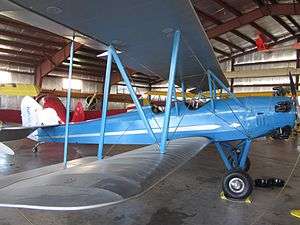Lincoln-Page PT
| Lincoln-Page PT | |
|---|---|
 | |
| Lincoln-Page PT-K | |
| Role | Primary Trainer |
| National origin | United States |
| Manufacturer | Lincoln-Page |
| Designer | A.H. Saxon |
| First flight | 1929 |
| Number built | 28+ |
| Developed from | Lincoln-Page LP-3 |
The Lincoln-Page PT was a trainer aircraft produced in the United States from 1929 to 1931.
Manufacture and operations
Lincoln-Page[1] were eager to take a share of the emerging trainer market. Using their Lincoln-Page LP-3 as a basis they set about designing the PT. The resultant aircraft was quite different from the LP-3, having tandem cockpits and a lengthened rear fuselage. The design bears a resemblance to the Swallow aircraft, partially from manager Victor Roos prior history with the company.[2] Structure was standard for its day:- welded steel tube warren girder fuselage with spruce spars and basswood ribs for the wings. With the ubiquitous Curtiss OX-5 the PT proved quite versatile and able to perform basic aerobatic manoeuvers without too much effort. It was awarded ATC no 181 in July 1929.[3]
The aircraft was also offered with a Curtiss OXX-6 100 hp engine, but no evidence exists that any were produced. However, a later variant using a Kinner K-5 radial engine was named Lincoln PT-K.
Surviving aircraft
An example of the PT-K version is preserved at the EAA AirVenture Museum.[4] In August 2014 three other examples of the PT design were registered by the Federal Aviation Administration as owned by private pilot owners in the United States.
Variants
- PT
- Production variant with a Curtiss OX-5 engine.
- PT-K
- Production variant with a Kinner K-5 radial engine
Specifications
Data from Specifications of American Commercial Airplanes[5], EAA Museum[6]
General characteristics
- Crew: 2
- Length: 23 ft 7 in (7.19 m)
- Wingspan: 32 ft 3 in (9.83 m)
- Height: 8 ft 10 in (2.69 m)
- Wing area: 297 sq ft (27.6 m2)
- Empty weight: 1,290 lb (585 kg)
- Gross weight: 1,800 lb (816 kg)
- Fuel capacity: 30 US gal (25 imp gal; 110 L)
- Powerplant: 1 × Curtiss OX-5 air-cooled V8 engine, 90 hp (67 kW)
- Propellers: 2-bladed fixed pitch propeller
Performance
- Maximum speed: 105 mph (169 km/h; 91 kn)
- Cruise speed: 90 mph (145 km/h; 78 kn)
- Range: 300 mi (261 nmi; 483 km)
- Service ceiling: 14,000 ft (4,300 m)
- Rate of climb: 800 ft/min (4.1 m/s)
- Landing speed: 38 mph (33 kn; 61 km/h)
See also
Aircraft of comparable role, configuration and era
- Swallow TP
- Command-Aire 3C3-T
References
- ↑ Lincoln-Page became Lincoln, however most contemporaries carried on calling the firm Lincoln-Page.
- ↑ "Lincoln-Page PT". Sport Aviation. August 1988.
- ↑ Juptner, Joseph P. (1963). U.S. Civil Aircraft Vol.2. Los Angeles: Aero Publishers. pp. 232–234.
- ↑ airventuremuseum.org
- ↑ Aviation March 22, 1930, pp. 606, 608, 610.
- ↑ "LINCOLN PT-K – N275N". EAA Museum website. Retrieved 22 September 2018.
| Wikimedia Commons has media related to Lincoln-Page PT. |
- "Specifications of American Commercial Airplanes". Aviation. Vol. 28 no. 12. March 22, 1930. pp. 606–611. (Registration required (help)).
External links
- "Lincoln-Page PT". 1000aircraftphotos.com. Retrieved 2008-10-19.